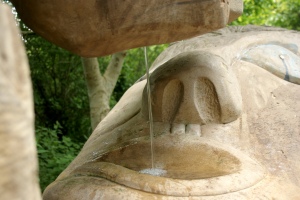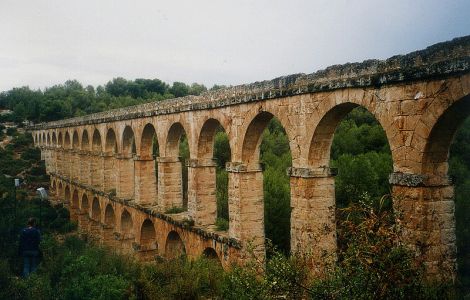As humans, we cannot survive without water. In the first world, we are privileged to have consistent access to fresh clean water. In many countries, access to water is based on one’s economic and social status, rather than being viewed as an inalienable human right. Lack of access to clean water kills 3.4 million people every year, and 780 million people lack access to clean safe water (To learn more about the crisis click here). While those of us in the Western world don’t see this side of water, we can still see how water can be a status symbol. Think about what your water consumption says about you: carrying a reusable water bottle shows that you are aware of being green and ecofriendly, whereas having Smart water bottles shows that you’re willing to pay a little more for the electrolytes, and we can’t forget the importance of having fancy bottle of water on the dinner table at a restaurant rather than accepting it from the tap. Around the world, water is controlled and displayed as an indicator of one’s position in society. But how can we learn about this in the past? How can we use this knowledge to better understanding social structures and restrictions in long gone societies? From the dead of course!
A new article from the American Journal of Physical Anthropology by Lightfoot, Slaus, and O’Connell (2014) examines patterns of water consumption in past populations. They argue that access to drinking water is often a social controlled and mediated behavior, and certain social groups may have had preferential access to certain sources of water. In order to examine this, they use stable isotope analysis. Oxygen isotope analysis of the enamel found in teeth can allow researchers to determine water intake during the period where teeth were still forming. This information has primarily been used to determine whether an individual is a migrant or local to a community. If oxygen isotope values in the teeth match the same values from local water, it is assumed that the individual was indigenous to the area, and vice versa if isotope values are different they are assumed to have migrated to this new area prior to death.
However, Lightfoot, Slaus, and O’Connell (2014) propose that another possible reason that there may be variability in oxygen isotope levels in a community is differential access to water sources. Further, the isotope levels can vary depending on how the water is prepared by boiling, stewing, brewing, and cooking with different materials. Due to this, they argue that “Oxygen isotope analysis can therefore be used to consider topics such as socially mediated access to water sources, the management of water, and variations in food and drink preparation techniques”.
The sites under investigation are found along the Croatian coast that was occupied during the Iron Age, became part of the Roman Empire in 34 BCE, was ruled by the Slavs following the collapse of the Western Roman Empire, and was settled ruled by the Croats in the Early Medieval period. Given these drastic changes, Lightfoot, Slaus, and O’Connell (2014) argue that there are likely significant changes in health, settlement patterns, diet, and social structure that may be better understood through an analysis of water control and consumption. There were numerous local water sources available, and with the rise of the Roman Empire, water based products like wine would have been traded from across Europe and aqueducts were built to bring in water from neighboring areas. This trade and long distance water movement would have declined following the end of the empire.
Tooth enamel samples were taken from 329 individuals that were found in 10 different cemeteries dating from the Iron Age to Early Medieval period, and for comparison 37 archaeological animal teeth were also sampled from various corresponding sites. The analysis of the human teeth shows that there is a clear statistical difference between oxygen isotope ratios in the three time periods (Iron Age, Roman Empire, Early Medieval). Explanations for these differences could include changes in climate, different water sources due to different habitation sites, migration of individuals, socially structured access to water or human manipulation of the water through cooking processes. Based on other forms of evidence including paleoclimate records, cemetery and settlement locations, and faunal isotopic analysis, they determined that the most probable cause for variation was that there was socially structured differential access to water, and different methods of cooking and brewing that led to different isotopic values in the water.
Based on the evidence, Lightfoot, Slaus, and O’Connell (2014) propose that beginning with the rise of the Roman Empire in this region, there were changes in the types of water or preparations of water in the Croatian coastal people. The rise of trade and aqueducts introduced new sources of water into the local diet. Further, during the Early Medieval Period, only certain individuals continued to have access to these foreign sources of water, and many people returned to local sources. A second possibility is that the new groups and influences during this period changed food preferences and preparation methods. Regardless, the differences in oxygen isotope ratios among these populations show that cultural change is the reason for differences in isotopic values. Most likely, individuals with more wealth in this region were able to maintain aqueducts following the end of the Roman Empire, whereas those with less wealth and power had to seek out local water sources.
Science Seeker: Editor’s Choice
Works Cited
![]() Lightfoot, E., Šlaus, M., & O’Connell, T. (2014). Water consumption in Iron Age, Roman, and Early Medieval Croatia American Journal of Physical Anthropology, 154 (4), 535-543 DOI: 10.1002/ajpa.22544
Lightfoot, E., Šlaus, M., & O’Connell, T. (2014). Water consumption in Iron Age, Roman, and Early Medieval Croatia American Journal of Physical Anthropology, 154 (4), 535-543 DOI: 10.1002/ajpa.22544



Reblogged this on Grave Matters: On Death and Burial and commented:
Great post that shows how archaeological and biological anthropological research on the past is relevant to the present.
Permission to reblog? Thank you.
Always feel free to reblog as long as there is clear authorship displayed and links to this site!
Thanks Katy! I loved this article.